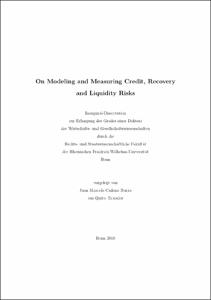On Modeling and Measuring Credit, Recovery and Liquidity Risks

On Modeling and Measuring Credit, Recovery and Liquidity Risks

| dc.contributor.advisor | Riedel, Frank | |
| dc.contributor.author | Cadena Ibarra, Juan Marcelo | |
| dc.date.accessioned | 2020-04-14T12:00:06Z | |
| dc.date.available | 2020-04-14T12:00:06Z | |
| dc.date.issued | 17.03.2010 | |
| dc.identifier.uri | https://hdl.handle.net/20.500.11811/4270 | |
| dc.description.abstract | We investigate three major risks of financial markets: credit, recovery and liquidity risks. Chapter 1 studies credit risk in an irreversible investment problem. The analysis demonstrates that optimal investment time is influenced unambiguously by credit risk. A clear cut direction of this influence is not available since debt-financed investment time depends on the parameters governing the dynamics of the value of the investment project, taxes and default costs. If the investor can exploit tax shields and default costs, a debt-financed investment occurs earlier than a cash-financed one. Contrary, if tax shields are low and default costs are large such that capital costs are high, cash-financed investments occur earlier than debt-financed ones. In Chapter 2 we analyze pricing methods for defaultable bonds. Recovery payment, default and recovery times are considered to be different random variables. Our pricing approach is manifold, valuations formulas are developed within three frameworks: structural model, intensity-based setup and mixed framework. The separation of default and recovery times introduces a new uncertainty source which is reflected in the bond price. Additionally, our approach allows a larger class of recovery payments than classical intensity-based models. The last part of this dissertation is dedicated to the measurement of liquidity risk. In Chapter 3 we consider financial assets whose future prices are random and depending on market conditions. An investor holding an asset portfolio is interested in measuring the possibility of value losses induced by liquidity restrictions, price-impact trading and lack of marketability. The investor may measure such risk by using a conventional measure of risk after adjusting for value losses due to liquidity risk. We analyze the implications in risk measurement when considering block trading and partial execution as components of liquidity risk. | en |
| dc.language.iso | eng | |
| dc.rights | In Copyright | |
| dc.rights.uri | http://rightsstatements.org/vocab/InC/1.0/ | |
| dc.subject.ddc | 330 Wirtschaft | |
| dc.title | On Modeling and Measuring Credit, Recovery and Liquidity Risks | |
| dc.type | Dissertation oder Habilitation | |
| dc.publisher.name | Universitäts- und Landesbibliothek Bonn | |
| dc.publisher.location | Bonn | |
| dc.rights.accessRights | openAccess | |
| dc.identifier.urn | https://nbn-resolving.org/urn:nbn:de:hbz:5-20519 | |
| ulbbn.pubtype | Erstveröffentlichung | |
| ulbbnediss.affiliation.name | Rheinische Friedrich-Wilhelms-Universität Bonn | |
| ulbbnediss.affiliation.location | Bonn | |
| ulbbnediss.thesis.level | Dissertation | |
| ulbbnediss.dissID | 2051 | |
| ulbbnediss.date.accepted | 12.03.2010 | |
| ulbbnediss.fakultaet | Rechts- und Staatswissenschaftliche Fakultät | |
| dc.contributor.coReferee | Lütkebohmert-Holtz, Eva |
Dateien zu dieser Ressource
Das Dokument erscheint in:
-
E-Dissertationen (284)




